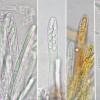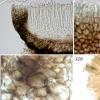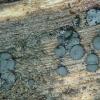
10-01-2026 20:00
Tom SchrierHi all,We found picnidia on Protoparmeliopsis mur

13-01-2026 07:28
 Danny Newman
Danny Newman
Chlorociboria glauca on indet. decorticate logThe

08-12-2025 17:37
 Lothar Krieglsteiner
Lothar Krieglsteiner
20.6.25, on branch of Abies infected and thickened

15-01-2026 15:55
 Lothar Krieglsteiner
Lothar Krieglsteiner
this one is especially interesting for me because

13-01-2026 08:43
 Danny Newman
Danny Newman
Tricladium varicosporioides on indet. decorticate

07-01-2026 22:22
 Danny Newman
Danny Newman
Tatraea sp. on indet. hardwood The Swag, Great Sm

13-01-2026 09:10
 Danny Newman
Danny Newman
Dasyscyphella chrysotexta on indet. decorticate ha
 Bonsoir,
Bonsoir, Je ne trouve pas d'identité pour ce Mollisia récolté sur branche de Salix au sol et ayant un aspect de Patellaria atrata: Apothécies 0,5-1,5 mm, noirâtres, sans marge relevée, à surface externe sublisse.
Asques 60-65 x 5 , PS 22 µm, spores 6-8 x 2-2,2 µm, OCI 0,5 (1)
Paraphyses x 4-5 µm
Cellules de l'ectal à parois brun rouge foncé , de diamètre jusqu'à 18 µm
Cellules marginales courtes, la dernière : 15-17 x 5-8 µm
KOH négatif
Merci pour tout indice.
Amitiés
Michel


M. cinerea is among the closest species which can be compared , indeed.
at least for spore shape and OCI,
Moreover it appears that even the smallest or new developped specimens are that black . Another feature seems distinctive: there is no white rim on the margin
But there are collections in your cinerea folder which look very similar
Amitiés
Michel


Normally the spores of your find are too short and narrow for M. cinerea.
Mollisia cinerea is in my opinion a species of the half-year approximately from november-april.
Take a look here at Zotto's IVV to this relatively recently described species:
https://drive.google.com/drive/u/0/folders/1bxySecfsFmqs9gYxo5tRg7JHileyLd_7?tid=0B5SeyOEkxxZhYVZub0N1aGY5YTg
Shape and color of apos could be a problem though.
Or it's just a new, undescribed one.
There are really quite a few of them.
Greetings
Ingo




